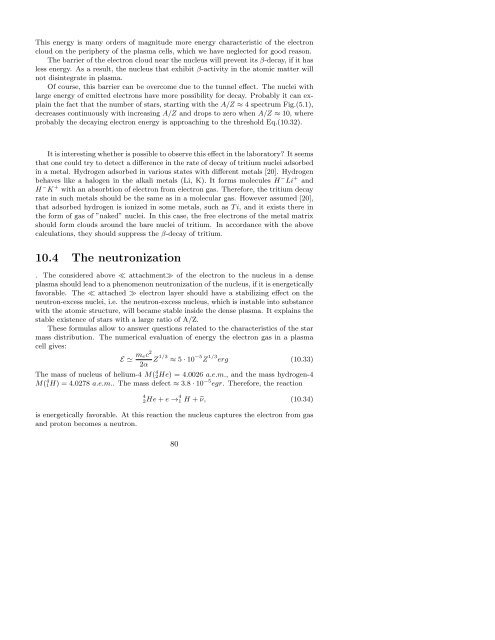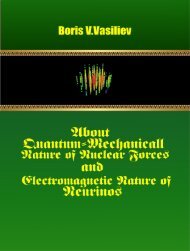VbvAstE-001
Book Boris V. Vasiliev Astrophysics
Book Boris V. Vasiliev
Astrophysics
Create successful ePaper yourself
Turn your PDF publications into a flip-book with our unique Google optimized e-Paper software.
This energy is many orders of magnitude more energy characteristic of the electron<br />
cloud on the periphery of the plasma cells, which we have neglected for good reason.<br />
The barrier of the electron cloud near the nucleus will prevent its β-decay, if it has<br />
less energy. As a result, the nucleus that exhibit β-activity in the atomic matter will<br />
not disintegrate in plasma.<br />
Of course, this barrier can be overcome due to the tunnel effect. The nuclei with<br />
large energy of emitted electrons have more possibility for decay. Probably it can explain<br />
the fact that the number of stars, starting with the A/Z ≈ 4 spectrum Fig.(5.1),<br />
decreases continuously with increasing A/Z and drops to zero when A/Z ≈ 10, where<br />
probably the decaying electron energy is approaching to the threshold Eq.(10.32).<br />
It is interesting whether is possible to observe this effect in the laboratory? It seems<br />
that one could try to detect a difference in the rate of decay of tritium nuclei adsorbed<br />
in a metal. Hydrogen adsorbed in various states with different metals [20]. Hydrogen<br />
behaves like a halogen in the alkali metals (Li, K). It forms molecules H − Li + and<br />
H − K + with an absorbtion of electron from electron gas. Therefore, the tritium decay<br />
rate in such metals should be the same as in a molecular gas. However assumed [20],<br />
that adsorbed hydrogen is ionized in some metals, such as T i, and it exists there in<br />
the form of gas of ”naked” nuclei. In this case, the free electrons of the metal matrix<br />
should form clouds around the bare nuclei of tritium. In accordance with the above<br />
calculations, they should suppress the β-decay of tritium.<br />
10.4 The neutronization<br />
. The considered above ≪ attachment≫ of the electron to the nucleus in a dense<br />
plasma should lead to a phenomenon neutronization of the nucleus, if it is energetically<br />
favorable. The ≪ attached ≫ electron layer should have a stabilizing effect on the<br />
neutron-excess nuclei, i.e. the neutron-excess nucleus, which is instable into substance<br />
with the atomic structure, will became stable inside the dense plasma. It explains the<br />
stable existence of stars with a large ratio of A/Z.<br />
These formulas allow to answer questions related to the characteristics of the star<br />
mass distribution. The numerical evaluation of energy the electron gas in a plasma<br />
cell gives:<br />
E ≃ mec2<br />
2α Z1/3 ≈ 5 · 10 −5 Z 1/3 erg (10.33)<br />
The mass of nucleus of helium-4 M( 4 2He) = 4.0026 a.e.m., and the mass hydrogen-4<br />
M( 4 1H) = 4.0278 a.e.m.. The mass defect ≈ 3.8 · 10 −5 egr. Therefore, the reaction<br />
4<br />
2He + e → 4 1 H + ˜ν, (10.34)<br />
is energetically favorable. At this reaction the nucleus captures the electron from gas<br />
and proton becomes a neutron.<br />
80













